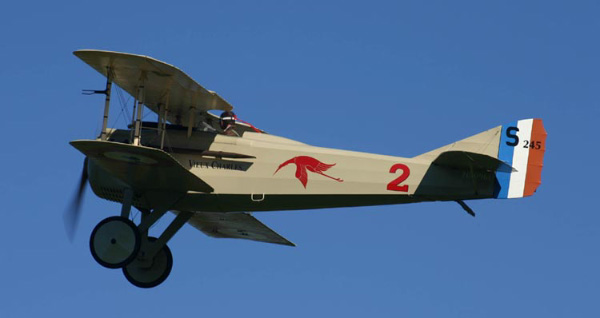
|
 |
SPAD S.VII |
 |
 |
 |
 |
 |
|---|---|---|---|---|---|---|---|
 |
 |
 |
 |
 |
|||
 |
||
|
The SPAD S.VII was one of the most successful fighters of World War I and was the first of a series of aircraft produced by the Société Pour L'Aviation et ses Dérivés (SPAD). It was a single-seat biplane that was sturdy and had good climbing rate to 12,000 ft. (3,660 m) and good diving characteristics. Although less maneuverable than the lightweight Nieuport 17, it proved to be a very stable gun platform. It made its inaugural flight in April 1916 and approximately 5,600 aircraft were built.1
The airplane was designed by Louis Bechereau who created the aircraft around the 150 hp Hispano-Suiza 8A engine that originated with the SPAD V. It was of standard construction for the period being built with a fabric covered wooden airframe with the forward fuselage covered with steel sheeting. Armament consisted of a .303 caliber Vickers machine gun that was mounted slightly to starboard on the forward fuselage and synchronized to fire through the propeller arc. |
| The aircraft was produced by eight different manufactures with the first order for the French for 268 aircraft with deliveries beginning on September 2, 1916. The early models were powered with the 150 hp Hispano-Suiza 8A engine which were later upgraded to 180 hp and 200 hp Hispano engines as they became available. |
|
Initial flight testing revealed an excellent speed of 119 mph (192 km/h) and climb rate of 4.5 min to 6,500 ft (2,000 m). With the later high power engines, the top airspeed increased to 129 mph (208 km/h).The combination of high speed and good diving characteristics gave Allied pilots the ability to engage or leave combat. While some aircraft reached the front in August of 1916, the bulk of deliveries would be in the first months of 1917.
It quickly became popular and by mid-1917, approximately 500 SPADs were in front-line service, having almost completely replaced the Nieuport. It served with numerous escadrilles de chasse including the famous SPA.3 Stork Group (Les Cigognes). The S.VII will always be associated with the Les Cicognes and the names of René Paul Fonck and Georges Guynemer. René Fonck was the top scoring Allied fighter ace in the First World War and Georges Guynemer was another top ace who became a French national hero and went missing in 1917. Allied air services began using the new fighter with the Royal Flying Corps being the first foreign service to be equipped, although only two squadrons (19 and 23 Squadrons) used it on the Western Front. Flight schools in the UK trained with the SPAD and 30 Squadron in Mesopotamia also received SPADs. Fifteen aircraft were supplied to the Escadrilles 5 and 10 of the Belgian Aviation Militaire and 214 SPADs were supplied to Italy where they equipped five squadriglie including the celebrated 91a, commanded by Francesco Baracca. Russia received a batch of 43 aircraft in spring 1917. In December 1917, 189 machines were bought by the United States and equipped seven squadrons of the American Expeditionary Force (AEF) with the remainder being sent to the United States as advanced trainers to prepare pilots for use of the SPAD XIII. |
| Specifications: | |
|---|---|
| SPAD S.VII | |
| Dimensions: | |
| Wing span: | 25 ft 8 in (7.81 m) |
| Length: | 19 ft 11 in (6.08 m) |
| Height: | 7 ft 2 in (2.20 m) |
| Weights: | |
| Empty: | 1,124 lb (510 kg) |
| Loaded Weight: | 1,632 lb (740 kg) |
| Performance: | |
| Maximum Speed: | 119 mph (192 km/h) |
| Rate of Climb: | 1,457 ft/min (444 m/min) |
| Range: | 225 miles (360 km) |
| Powerplant: | |
| One 150 hp (111 kW) Hispano-Suiza 8A V-8 water cooled engine. | |
| Armament: | |
| One .303 caliber Vickers machine gun. | |
| Endnotes: |
|---|
|
1. Kenneth Munson. The Pocket Encyclopedia of World Aircraft in Color. Fighters 1914-19. Attack and Training Aircraft. New York: The MacMillan Company, 1969. 124-125. |
©Larry Dwyer. The Aviation History Online Museum.
All rights reserved.
Created April 17, 1997. Updated November 16, 2013.